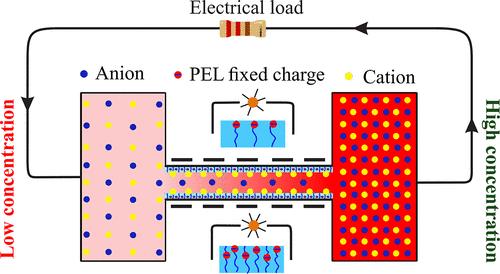Our official English website, www.x-mol.net, welcomes your
feedback! (Note: you will need to create a separate account there.)
Maximizing Blue Energy via Densely Grafted Soft Layers in Nanopores
Langmuir ( IF 3.7 ) Pub Date : 2024-11-19 , DOI: 10.1021/acs.langmuir.4c03192 Md Ismayeel, Sumit Kumar Mehta, Pranab Kumar Mondal
Langmuir ( IF 3.7 ) Pub Date : 2024-11-19 , DOI: 10.1021/acs.langmuir.4c03192 Md Ismayeel, Sumit Kumar Mehta, Pranab Kumar Mondal

|
We investigate energy generation from salinity gradients inside a nanopore that is connected to reservoirs at both ends. We consider that the inner wall surfaces are grafted with a densely grafted polyelectrolyte layer (PEL). We developed the PEL grafting density-dependent correlation of dielectric permittivity, molecular diffusivity, and dynamic viscosity in this endeavor. Using these correlations, we employ the finite element framework to solve the equations describing the ionic and fluidic transport. We use a partially hydrolyzed polyacrylamide polymer solution, which exhibits a shear-thinning fluid, in combination with the KCl electrolyte for energy-harvesting analysis. To describe the shear-rate-dependent apparent viscosity of non-Newtonian liquid, we have employed the Carreau model. For a window of right-side reservoir concentration, we investigate the effects of ion-partitioning in conjugation with the change in PEL grafting density on the ionic field, ionic selectivity, pore current, osmotic power, energy conversion efficiency, and flow field. The findings of this endeavor demonstrate how the ion-partitioning effect lowers the screening effect and raises the electrical double layer (EDL) potential by reducing the counterions in PEL. We show that the unique distribution of the ionic field leads to a higher prediction of generated osmotic power and power density due to the ion-parting effect. Additionally, we establish that the augmentation in PEL space charge density leads to improvement in average flow velocity, osmotic power, and consequently energy conversion efficiency. We establish that the generated osmotic power density and the energy conversion efficiency become very high at the higher grafting density. In summary, inferences of this analysis are deemed pertinent in designing the nanoscale device intended for high and efficient osmotic energy generation.
中文翻译:

通过纳米孔中密集接枝的软层最大化蓝色能量
我们研究了从两端连接到储层的纳米孔内的盐度梯度产生能量。我们认为内壁表面接枝了致密接枝的聚电解质层 (PEL)。在此过程中,我们开发了介电常数、分子扩散率和动态粘度的 PEL 接枝密度依赖性相关性。利用这些相关性,我们采用有限元框架来求解描述离子和流体传输的方程。我们使用部分水解聚丙烯酰胺聚合物溶液(表现出剪切稀化液)与 KCl 电解质相结合进行能量收集分析。为了描述非牛顿液体的剪切速率依赖性表观粘度,我们采用了 Carreau 模型。对于右侧储层浓度窗口,我们研究了离子分配与 PEL 接枝密度变化对离子场、离子选择性、孔隙电流、渗透功率、能量转换效率和流场的影响。这项工作的结果证明了离子分配效应如何通过减少 PEL 中的反离子来降低屏蔽效应并提高双电层 (EDL) 电位。我们表明,由于离子分离效应,离子场的独特分布导致对产生的渗透功率和功率密度的预测更高。此外,我们确定 PEL 空间电荷密度的增加会导致平均流速、渗透功率的提高,从而提高能量转换效率。我们确定,在较高的接枝密度下,产生的渗透功率密度和能量转换效率变得非常高。 总之,该分析的推论被认为与设计用于高效渗透能产生的纳米级器件相关。
更新日期:2024-11-20
中文翻译:

通过纳米孔中密集接枝的软层最大化蓝色能量
我们研究了从两端连接到储层的纳米孔内的盐度梯度产生能量。我们认为内壁表面接枝了致密接枝的聚电解质层 (PEL)。在此过程中,我们开发了介电常数、分子扩散率和动态粘度的 PEL 接枝密度依赖性相关性。利用这些相关性,我们采用有限元框架来求解描述离子和流体传输的方程。我们使用部分水解聚丙烯酰胺聚合物溶液(表现出剪切稀化液)与 KCl 电解质相结合进行能量收集分析。为了描述非牛顿液体的剪切速率依赖性表观粘度,我们采用了 Carreau 模型。对于右侧储层浓度窗口,我们研究了离子分配与 PEL 接枝密度变化对离子场、离子选择性、孔隙电流、渗透功率、能量转换效率和流场的影响。这项工作的结果证明了离子分配效应如何通过减少 PEL 中的反离子来降低屏蔽效应并提高双电层 (EDL) 电位。我们表明,由于离子分离效应,离子场的独特分布导致对产生的渗透功率和功率密度的预测更高。此外,我们确定 PEL 空间电荷密度的增加会导致平均流速、渗透功率的提高,从而提高能量转换效率。我们确定,在较高的接枝密度下,产生的渗透功率密度和能量转换效率变得非常高。 总之,该分析的推论被认为与设计用于高效渗透能产生的纳米级器件相关。


















































 京公网安备 11010802027423号
京公网安备 11010802027423号